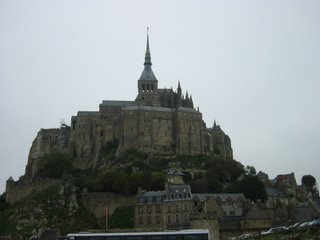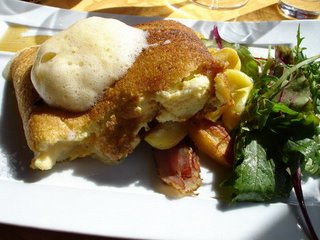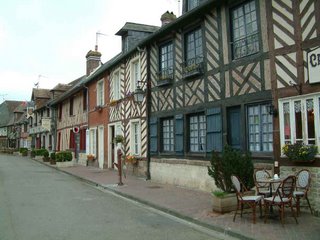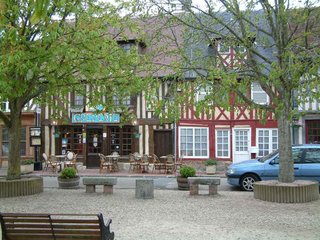Normandy: Le Mont-Saint-Michel and God’s Town of the Frying Pans
Somewhat late, we’ll give you a quick summary of the rest of our Normandy trip.
 One day, we took the fairly long drive (90 minutes) to Mont Saint Michel, the famous Abbey that is probably one of the most photographed places in France. The tides that flow in to surround the island are the highest in Europe and signs are posted in various spots to warn you that if you park there your car will be under water by high tide. On a Monday out of season, we still had to fight our way through dozens of busloads of tourists (mostly Japanese) to get into the walled town and to climb several hundred steps to the top from where we could tour the Abbey. All I will say about the climb is that it wasn’t the older members of the party who complained about the effort involved. The Abbey was beautiful, however and the self guided walk through the various parts was all downhill. We were also lucky to share the tour with a group of German Gregorian Chanters, who tested the acoustics of each stone chapel and hall with amazing chants sung in multi-part harmony. On the way out we again struggled through the crowds in the narrow shopping street of the walled town and we resisted the urge
One day, we took the fairly long drive (90 minutes) to Mont Saint Michel, the famous Abbey that is probably one of the most photographed places in France. The tides that flow in to surround the island are the highest in Europe and signs are posted in various spots to warn you that if you park there your car will be under water by high tide. On a Monday out of season, we still had to fight our way through dozens of busloads of tourists (mostly Japanese) to get into the walled town and to climb several hundred steps to the top from where we could tour the Abbey. All I will say about the climb is that it wasn’t the older members of the party who complained about the effort involved. The Abbey was beautiful, however and the self guided walk through the various parts was all downhill. We were also lucky to share the tour with a group of German Gregorian Chanters, who tested the acoustics of each stone chapel and hall with amazing chants sung in multi-part harmony. On the way out we again struggled through the crowds in the narrow shopping street of the walled town and we resisted the urge to buy souvenirs, although Brian was strongly tempted by a full-size suit of armour – perfect for that empty corner of the dining room. Hungry by now, we looked for an appropriate restaurant. There is always a local speciality that one is supposed to try and in Mont Saint Michel it is omelettes. We decided to pass up the famous restaurant Mere Poulard (home of the $30 omelette) which had a crowd waiting anyway and we settled instead on toasted panini sandwiches and McCain french fries in a casse-croute. Hardly gourmet, but the Belgian draft beer (brewed by monks, you know) added a touch of historical authenticity.
to buy souvenirs, although Brian was strongly tempted by a full-size suit of armour – perfect for that empty corner of the dining room. Hungry by now, we looked for an appropriate restaurant. There is always a local speciality that one is supposed to try and in Mont Saint Michel it is omelettes. We decided to pass up the famous restaurant Mere Poulard (home of the $30 omelette) which had a crowd waiting anyway and we settled instead on toasted panini sandwiches and McCain french fries in a casse-croute. Hardly gourmet, but the Belgian draft beer (brewed by monks, you know) added a touch of historical authenticity.
 We decided to take back roads on the return trip to our chambre d’hôte, travelling through Suisse Normande, so named because the hills and valleys of rich farmland are similar to Switzerland. Navigating the route Brian took us towards a town called Villedieu-les-poêles. Remembering the unfortunate overly-literal translation of our hosts (see below), Brian joked that this must be “God’s town of the frying pans”. We arrived to find that is exactly what it is – a town that has been known for fabricating pots and pans since the 11th century – the main street filled with shops that overflow with copperware of all shapes and sizes. The town is also now known for one of the few remaining foundries in France manufacturing large bells for church towers. Further on we drove through Falaise. We were losing the light but the immense ruin of the fortress that was the home base of William the Conqueror was impressive and something we’ll go back to see more closely. Falaise is also known from World War 2 for the last major fight in the battle of Normandy. Canadian troops suffered heavy losses but were instrumental in closing “the Falaise Gap” to encircle and effectively destroy the remaining German army. We drove on back to Pont l’Eveque for another large dinner, but the culinary entry in the blog is still to come, so I won’t elaborate here.
We decided to take back roads on the return trip to our chambre d’hôte, travelling through Suisse Normande, so named because the hills and valleys of rich farmland are similar to Switzerland. Navigating the route Brian took us towards a town called Villedieu-les-poêles. Remembering the unfortunate overly-literal translation of our hosts (see below), Brian joked that this must be “God’s town of the frying pans”. We arrived to find that is exactly what it is – a town that has been known for fabricating pots and pans since the 11th century – the main street filled with shops that overflow with copperware of all shapes and sizes. The town is also now known for one of the few remaining foundries in France manufacturing large bells for church towers. Further on we drove through Falaise. We were losing the light but the immense ruin of the fortress that was the home base of William the Conqueror was impressive and something we’ll go back to see more closely. Falaise is also known from World War 2 for the last major fight in the battle of Normandy. Canadian troops suffered heavy losses but were instrumental in closing “the Falaise Gap” to encircle and effectively destroy the remaining German army. We drove on back to Pont l’Eveque for another large dinner, but the culinary entry in the blog is still to come, so I won’t elaborate here.

 On the next day we headed back to Paris. Our first morning stop was just a few minutes from our chambre-d'hôte, the medieval town of Beuvron-en-Auge. It has a beautiful main street filled with timbered buildings that are now shops and restaurants catering to tourists. Despite this, and perhaps because it is out of the way, it has a very quiet and charming character. Or should I say it did ... before the tour bus rolled in, disgorging its contents of young Japanese women who set to work taking photos of each other flashing V signs in front of the old buildings and buying up the contents of all the shops. Luckily we already had our box of the local specialty - shortbread biscuits (sablé).
On the next day we headed back to Paris. Our first morning stop was just a few minutes from our chambre-d'hôte, the medieval town of Beuvron-en-Auge. It has a beautiful main street filled with timbered buildings that are now shops and restaurants catering to tourists. Despite this, and perhaps because it is out of the way, it has a very quiet and charming character. Or should I say it did ... before the tour bus rolled in, disgorging its contents of young Japanese women who set to work taking photos of each other flashing V signs in front of the old buildings and buying up the contents of all the shops. Luckily we already had our box of the local specialty - shortbread biscuits (sablé).
 We headed onwards to the coast and stopped in Honfleur. This beautiful port town sits at the mouth of the River Seine where it flows into the Channel. It was a centre of impressionist painting and the harbour is subject of many well-known artworks. More important for Canadians perhaps is the fact that Samuel de Champlain sailed from Honfleur in 1608 to found Quebec City and begin the permanent settlement of Canada by Europeans. The Normandy-Quebec historical links are obvious, from the habitant-style toques that one sees (in the pictures) here, to the back streets of Honfleur that look remarkably like the old streets of Vieux-Quebec. A celebration of the 400th anniversary is in the planning stages that will be huge in Quebec and will have events here.
We headed onwards to the coast and stopped in Honfleur. This beautiful port town sits at the mouth of the River Seine where it flows into the Channel. It was a centre of impressionist painting and the harbour is subject of many well-known artworks. More important for Canadians perhaps is the fact that Samuel de Champlain sailed from Honfleur in 1608 to found Quebec City and begin the permanent settlement of Canada by Europeans. The Normandy-Quebec historical links are obvious, from the habitant-style toques that one sees (in the pictures) here, to the back streets of Honfleur that look remarkably like the old streets of Vieux-Quebec. A celebration of the 400th anniversary is in the planning stages that will be huge in Quebec and will have events here.
We ate a traditional lunch in a harbourside café - steamed mussels followed by Ben and Jerry’s - before piling into the car for the two-hour drive back to Paris. Satisfied with our first busy but enjoyable trip in France, we nevertheless dreaded the looming encounter with the bathroom scale.
 One day, we took the fairly long drive (90 minutes) to Mont Saint Michel, the famous Abbey that is probably one of the most photographed places in
One day, we took the fairly long drive (90 minutes) to Mont Saint Michel, the famous Abbey that is probably one of the most photographed places in  to buy souvenirs, although Brian was strongly tempted by a full-size suit of armour – perfect for that empty corner of the dining room. Hungry by now, we looked for an appropriate restaurant. There is always a local speciality that one is supposed to try and in Mont Saint Michel it is omelettes. We decided to pass up the famous restaurant Mere Poulard (home of the $30 omelette) which had a crowd waiting anyway and we settled instead on toasted panini sandwiches and McCain french fries in a casse-croute. Hardly gourmet, but the Belgian draft beer (brewed by monks, you know) added a touch of historical authenticity.
to buy souvenirs, although Brian was strongly tempted by a full-size suit of armour – perfect for that empty corner of the dining room. Hungry by now, we looked for an appropriate restaurant. There is always a local speciality that one is supposed to try and in Mont Saint Michel it is omelettes. We decided to pass up the famous restaurant Mere Poulard (home of the $30 omelette) which had a crowd waiting anyway and we settled instead on toasted panini sandwiches and McCain french fries in a casse-croute. Hardly gourmet, but the Belgian draft beer (brewed by monks, you know) added a touch of historical authenticity. We decided to take back roads on the return trip to our chambre d’hôte, travelling through Suisse Normande, so named because the hills and valleys of rich farmland are similar to
We decided to take back roads on the return trip to our chambre d’hôte, travelling through Suisse Normande, so named because the hills and valleys of rich farmland are similar to 
 On the next day we headed back to
On the next day we headed back to  We headed onwards to the coast and stopped in Honfleur. This beautiful port town sits at the mouth of the River Seine where it flows into the Channel. It was a centre of impressionist painting and the harbour is subject of many well-known artworks. More important for Canadians perhaps is the fact that Samuel de Champlain sailed from Honfleur in 1608 to found
We headed onwards to the coast and stopped in Honfleur. This beautiful port town sits at the mouth of the River Seine where it flows into the Channel. It was a centre of impressionist painting and the harbour is subject of many well-known artworks. More important for Canadians perhaps is the fact that Samuel de Champlain sailed from Honfleur in 1608 to found 

2 Comments:
Wow, the pictures from your trip are amazing!! And you know I would have preferred the McCain Fries to the omelettes anyways! I can't wait to see the French countryside with you in December!
love, Alison
Finally had an opportunity to look at your blog and see the final entry for your long weekend in Normandy. You've done a fabulous job of relaying your impressions through words and pictures. Can't wait to make the trip there when we come to Paris!
Love, Heather
Post a Comment
<< Home